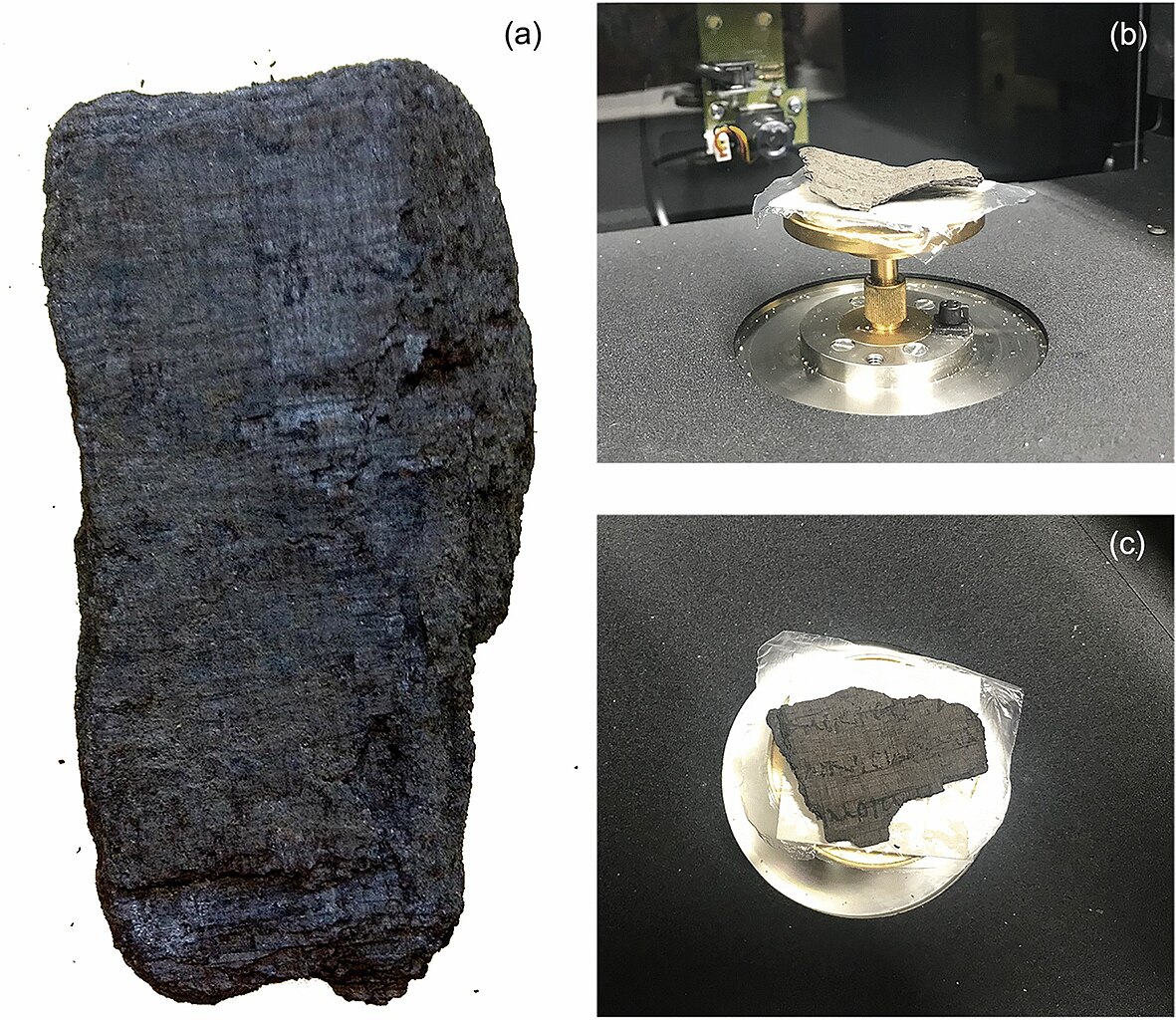
ΑΙhub.org
AI will let us read ‘lost’ ancient works in the library at Herculaneum for the first time
 Photos of the papyrus fragments PHerc.1103 (a) and PHerc.110 (b,c). Source: “A computational platform for the virtual unfolding of Herculaneum Papyri”. Reproduced under a CC BY 4.0 license.
Photos of the papyrus fragments PHerc.1103 (a) and PHerc.110 (b,c). Source: “A computational platform for the virtual unfolding of Herculaneum Papyri”. Reproduced under a CC BY 4.0 license.
By Michael McOsker, UCL
On 19 October 1752, a discovery was made 20 metres underneath the town of Resina, near Naples in Italy. Peasants digging wells in the area around Mount Vesuvius had struck marble statuary and mosaic pavements – and they also found lumps of carbon.
Initially, they were tossed aside – the lumps weren’t considered valuable or pretty, so were of no interest. But thankfully, someone noticed they were all about the same size and shape, and investigated further. It was soon discovered the carbonised lumps they thought were rolled-up hunting or fishing nets, or bolts of cloth, in fact contained writing.
What these peasants had found turned out to be a huge building from the ancient Roman age, when the town was known as Herculaneum. Recent re-excavations suggest that nearly three square kilometres of it have never been explored. The carbonised lumps turned out to be papyrus scrolls belonging to a great library full of Roman writing that had been thought lost. For this reason, the building is now known as the Villa dei Papiri.
Papyrus is an Egyptian reed and type of paper common in the ancient Mediterranean that was made from its pith. When Vesuvius erupted in AD79 – the same eruption that buried Pompeii – the papyrus rolls in the villa were carbonised. Without enough oxygen to combust and turn to ash, they became charcoal instead.
This meant the scrolls were fused solid and to get at the writing inside, they had to be opened. This process has been ongoing since the 1750s and researchers have just entered a new stage, thanks to AI. The lumps of carbonised scroll have been digitally scanned and, using 3D mapping and AI, researchers have been able to “virtually unroll” the papyri and detect letters. This process has, for example, allowed them to read a previously unknown philosophical work discussing the senses and pleasure by the Epicurean philosopher and poet, Philodemus.
I have worked on the scrolls in the Herculaneum library since 2010, when I began my PhD thesis on Philodemus’s text On Poems. I worked on the papyri in Naples for a year and a half from 2013, and still visit them nearly every summer.
The news that we could finally read these still rolled-up papyri hit me like a lightning bolt. In the past, opening the scrolls, even those in excellent condition that unrolled easily, caused damage to them – especially the outsides that contain the beginning of each text. This means no one alive has ever read the first sentence of a Herculaneum text, only the first visible, surviving sentence.
Unrolling and reading the library
When research on the scrolls began in the mid-18th century, the rolls were simply cut into halves or more pieces, then the insides were scooped out until legible text was revealed. The drawback of this approach is obvious – large parts of the best-preserved parts of scrolls were destroyed – so a better solution was sought.
In 1753, Italian priest and scholar Antonio Piaggio, on loan from the Vatican library, invented a machine to unroll the papyri by slowly pulling the outer layer off. Hundreds of Herculaneum papyri were thus unrolled, though their harder outer bits were cut off to get at the better preserved insides. Piaggio’s machine was remarkably successful, and the papyri unrolled on it have fuelled two-and-a-half centuries of scholarship so far.
But not every scroll could be unrolled this way – and up to 300 of these still rolled-up scrolls, out of the 800 or so found originally, have been set aside until now.
The Herculaneum library contains mostly works of Epicurean philosophy. This is a strand of philosophy founded around 307BC, based on the teachings of Epicurus – an ancient Greek philosopher who believed that a correct understanding of physics, backed up by rigorous argument, was necessary to achieve happiness, because it removed human fears about the gods (they don’t care about us), natural phenomena (not signs of divine anger), and post-mortem punishment (our souls do not survive our deaths).
Philodemus of Gadara is the most common author in the library. One copy of his History of Plato’s Academy was probably his own draft, so we can be confident the library is made up in part from his books. This is also why we think the owner of the villa was Julius Caesar’s father-in-law, L. Calpurnius Piso Caesoninus: we know Philodemus was his personal philosopher, and only the highest Roman elite could afford a house that big.
Epicurus makes up a substantial proportion of the library too – especially On Nature, his magnum opus. Other Epicureans have been textually resurrected as well, including Metrodorus and Demetrius the Spartan.
There are also works by the Stoic philosopher Chrysippus, as well as papyri in Latin. Most legible of these is a poem about the Battle of Actium: the battle on September 2, 31 BC, in which Octavian defeated Mark Antony. Seneca the Elder’s Histories have also recently been identified.
What will we find?
People have dreamed about discovering “lost” works in libraries such as Herculaneum. The art historian Johann Joachim Winckelmann wanted to discover works by the historians Diodorus, Theopompus and Ephorus, lost Aristotle, more Sophocles and Euripies, comedies by Menander and Alexis, and ancient scholarship on art. The poet William Wordsworth wanted the Greek poets Pindar and Simonides.
The chances of finding lost Ancient Greek literature are slim because none has so far been found in the Herculaneum library, though it would be thrilling. But there’s real hope for more Latin literature at Herculaneum – lost works from the first centuries BC and AD.
The safest bet for what we will read now with the aid of AI in Herculaneum is more of what we already have. There will be more Philodemus and, as a scholar of his work, I am over the moon about this. Every new text is important – making our knowledge deeper, more textured and more accurate. I cannot really bring myself to hope for one specific text or another. As Epicurus himself put it: “One should not have vain desires that cannot be fulfilled.”
![]()
Michael McOsker, Research Fellow in Papyrology, UCL
This article is republished from The Conversation under a Creative Commons license. Read the original article.
Find out more
First passages of rolled-up Herculaneum scroll revealed, Nature News.
tags: NeurIPS









